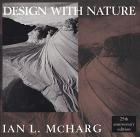Book Review
Design with Nature
by Ian L. Mcharg
Paperback
- 208 pages
1 edition (February 6, 1995)
John Wiley & Sons
The former sustainable design editor of Wiley Books, now with Island Press, is an Ian McHarg fan and related the following story over a latte. After soldiering in World War Two McHarg, a Scottsman by birth, returned home and determined what to do with the rest of his life. For reasons he discusses in Design with Nature, McHarg decided on landscape architecture, an academic discipline and profession he knew nothing about.
He learned that Harvard University, in distant New England, had a good program, so he wrote that august institution a letter informing them of his intention to study there. He did not apply, mind you, or complete any pre requisite undergraduate courses. He just told Harvard when he was coming, appeared on schedule, and began taking classes, never considering any possibility but his admittance to a course of study. Unsure as to how to handle the upstart designer, the academic authorities opened their classrooms and granted him his degree, or, in his words, "After the war I spend four years at Harvard where I received assurances that I was a professional landscape architect and city planner."
An iconoclast from the get go, McHarg wrote what many consider to be the ecological design classic in a very personal, very untextbook-like style. A native genius, he refuses to be constrained by traditional categories that separate self from others, civilization from ecology. It is this very personal touch that keeps Design with Nature atop the charts more than thirty years after it first appeared. No one better expresses the essence of his work better than McHarg himself:
This book is a personal testament to the power of sun, moon, and stars, the changing seasons, seedtime and harvest, clouds, rain and rivers, the oceans and the forests, the creatures and the herbs. They are with us now, co-tenants of the phenomenal universe, participating in that timeless yearning that is evolution, vivid expressions of time past, essential partners in survival and with us now involved in the creation of the future.
Our eyes do not divide us from the world, but unite us with it. Let this be known to be true. Let us then abandon the simplicity of separation and give unity its due. Let us abandon the self mutilation which has been our way and give expression to the potential harmony of man-nature. The world is abundant, we require only a deference born of understanding to fulfill man's promise. Man is that uniquely conscious creature who can perceive and express. He must become the steward of the biosphere. To do this he must design with nature.
Along with the poetry we get the instruction of a master, masterfully expressed. "McHargian," in ecological design circles, means following McHarg's now classic method's of landscape analysis in the planning of human settlements. Essentially step-by-step instructions inform the reader who, in McHarg's mind, is a future designer, on how to break down a region into its appropriate uses. Pointing out that we build where we should farm, cut forests where we should grow them, and design forms where we should follow nature's morphologies, McHarg makes clear and comprehensible recommendations for reversing the destructive process of development.
If McHarg's book can be criticized at all, it is only from our current perspective. Design with Nature falls short of describing a complete, cyclical ecology, and focuses mostly on patterns of land use and the morphology of human settlements. This deficiency is in part a reflections of the book's era—suburban sprawl was seen by many as the principal threat to the natural environment in the late 1960's. As did many of his contemporaries, including Frank Lloyd Wright, McHarg views the automobile as a permanent fixture, and discusses how highways can be better situated in the landscape, not eliminated or scaled back.
Design with Nature, however, does not pretend to be a textbook of ecological design as way we currently understand the field. McHarg was bent on preservation, and the reintroduction of nature to the city. In this, no one has instructed us better—or more eloquently.
